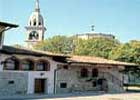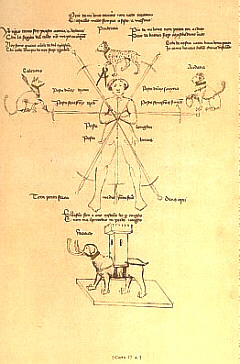Maestro Fiore dei Liberi
Prologue (Pisani-Dossi, 1410)
Fiore dei Liberi of Cividale d'Austria was born sometime between 1340
and 1350 born in Premariacco in Friuli,
  |
| The coat of arms of Premariacco, click for more details |
a small town next to the river Natisone
 |
| An image of the first page of the prologue found in the Pisani-Dossi version of Flos Duellatorum. Click on image to view larger of the same |
in Italy. Given that he had written the treatise "Flos Duellatorum" between
the years of 1409 and 1410, and that according to the information in the
prologue of the manuscript, he had been practicing the art of swordsmanship
for 50 years at the time of his writing, the birth year is an estimate.
With the exception of what is written in the prologue of his treatise, very little is known about Fiore dei Liberi. The illustration on the left depicts a
portion of the prologue. What the prologue does describe is that his family is of noble origin, however, but not
well placed. He initially learned the art of swordsmanship as a child and
young man in his village where he fought in friendly assaults and duels
as was the custom in that period. However, in order to learn the art from
the best of his time, he left his village and went to Germany to learn
and train in  |
| An image of the "sette spada" or "seven swords" found in the Pissan-Dossi version of Flos Duellatorum. This illustration depicts all of the sword angles of attack and defense. Click on image to view larger of the same |
swordsmanship
under the direction of the scholar Johannes Suvenus (a former scholar
of Nicolaus con Toblem). The knowledge he acquired under Johane's
direction elevated Fiore dei Liberi to a master swordsman of his time.
He participated in numerous battles in and around Italy for the last
20 years of the 14th century. In 1383 he fought in Udine on the side of the town during the civil war. In 1395 he was in Padua for
a duel and four years later in 1399 he was in Pavia. Little is known of
his life and deeds around this time until the beginning of 1400, he entered the court of Niccolo III dEste, Marquise of Ferrara, as the
master swordsman. He acquired a commission in the early 1400's as a master
swordsman on behalf of Signore di Ferrara. He then began to write the manuscript
for the nobility on behalf of Signore di Ferrara. In 1410 Fiore dedicated
his treatise to his Marquise. After 1410 there are no records of his life
or of his death. It is believed that he died some time before 1450.
Prologue, courtesy of video created by his company "Compagnia de' Malipiero", entitled "Medieval Swordfighting: In the Style of Fiori de' Liberi of XIV Century", produced by Arte Video, and distributed by By the Sword.
Flos Duellatorum, or 'Flower of Battle' is primarily composed of illustrations
with short rhyming captions in Italian. Sections on wrestling, dagger,
sword, spear, two handed sword, armored combat, pollaxe, and mounted combat.
Considerable discussion of disarming techniques. Two-handed sword (spadone)
has the greatest emphasis. The figure to the right is an example of one
of the illustrations that depicts the formal angles of attack found in
his treatise.




